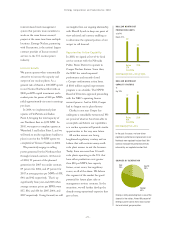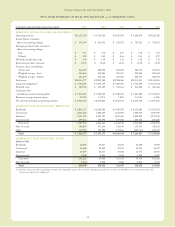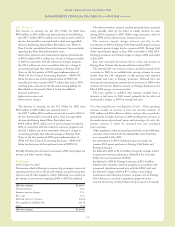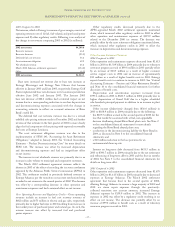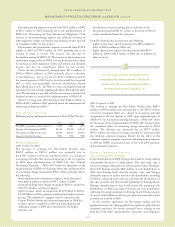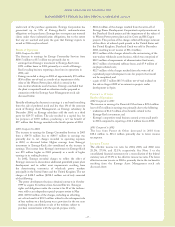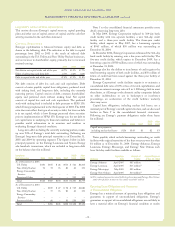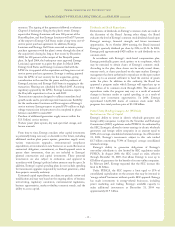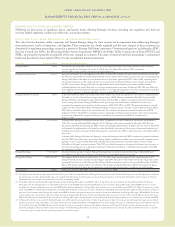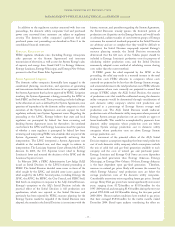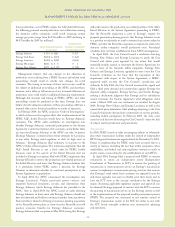Entergy 2004 Annual Report Download - page 30
Download and view the complete annual report
Please find page 30 of the 2004 Entergy annual report below. You can navigate through the pages in the report by either clicking on the pages listed below, or by using the keyword search tool below to find specific information within the annual report.
-28 -
Entergy Corporation and Subsidiaries 2004
LIQUIDITY AND CAPITAL RESOURCES
This section discusses Entergy’s capital structure, capital spending
plans and other uses of capital, sources of capital, and the cash flow
activity presented in the cash flow statement.
Capital Structure
Entergy’s capitalization is balanced between equity and debt, as
shown in the following table. The reduction in the debt to capital
percentage from 2002 to 2003 is the result of reduced debt
outstanding in the U.S. Utility and Non-Utility Nuclear businesses,
and an increase in shareholders’ equity, primarily due to increased
retained earnings.
2004 2003 2002
Net debt to net capital at the end of the year 44.7% 45.3% 47.7%
Effect of subtracting cash from debt 2.7% 2.2% 4.1%
Debt to capital at the end of the year 47.4% 47.5% 51.8%
Net debt consists of debt less cash and cash equivalents. Debt
consists of notes payable, capital lease obligations, preferred stock
with sinking fund, and long-term debt, including the currently
maturing portion. Capital consists of debt, commonshareholders’
equity, and preferred stock without sinking fund. Net capital
consists of capital less cash and cash equivalents. The preferred
stockwith sinking fund is included in debt pursuant to SFAS 150,
which Entergy implemented in the third quarter of 2003. The 2002
ratio does not reflect that type of security as debt, but does include
it in net capital, which is how Entergy presented those securities
prior to implementation of SFAS 150. Entergy uses the net debt to
net capital ratio in analyzing its financial condition and believes it
provides useful informationto its investors and creditors in
evaluating Entergy’s financial condition.
Long-term debt, including the currently maturing portion, makes
up over 90% of Entergy’s total debt outstanding. Following are
Entergy’s long-term debt principal maturities as of December 31,
2003 and 2004 by operating segment. The figures below include
principal payments on the Entergy Louisiana and System Energy
sale-leaseback transactions, which are included in long-term debt
on the balance sheet (in millions):
Long-term 2008- After
Debt Maturities 2004 2005 2006 2007 2009 2009
As of December 31, 2003
U.S. Utility $450 $355 $ 28 $573 $ 721 $4,305
Non-Utility Nuclear 74 72 76 80 40 173
EnergyCommodity
Services – – – – – –
Parent and Other – 60 – – 539 301
Total $524 $487 $104 $653 $1,300 $4,779
As of December 31, 2004
U.S. Utility – $359 $ 27 $ 98 $ 749 $4,880
Non-Utility Nuclear – 77 76 80 40 173
EnergyCommodity
Services – – – – – –
Parent and Other – 60 – 50 539 301
Total – $496 $103 $228 $1,328 $5,354
Note 5 to the consolidated financial statements provides more
detail concerning long-term debt.
In May 2004, Entergy Corporation replaced its 364-day bank
credit facility with two separate facilities, a new 364-day credit
facility and a three-year credit facility. The three-year credit
facility, which expires in May 2007, has a borrowing capacity
of $965 million, of which $50 million was outstanding at
December 31, 2004.
In December 2004, Entergy Corporation refinanced the 364-day
bank credit facility by entering into a five-year credit facility. The
five-year credit facility, which expires in December 2009, has a
borrowing capacity of $500 million, none of which was outstanding
at December 31, 2004.
Entergy also has the ability to issue letters of credit against the
total borrowing capacity of both credit facilities, and $50 million of
letters of credit had been issued against the three-year facility at
December 31, 2004.
EntergyCorporation’s credit facilities require it to maintain a
consolidated debt ratio of 65% or less of its total capitalization, and
maintain an interest coverage ratio of 2 to 1. If Entergy fails to meet
these limits, or if Entergy or the domestic utility companies default
on other indebtedness or are in bankruptcy or insolvency
proceedings, an acceleration of the credit facilities’ maturity
dates may occur.
Capital lease obligations, including nuclear fuel leases, are a
minimal part of Entergy’s overall capital structure, and are discussed
further in Note 9 to the consolidated financial statements.
Following are Entergy’s payment obligations under those leases
(in millions):
2008- After
2005 2006 2007 2009 2009
Capital lease payments,
including nuclear fuel leases $136 $143 $3 $2 $3
Notes payable, which include borrowings outstanding on credit
facilities with original maturities of less than one year, were less than
$1 million as of December 31, 2004. Entergy Arkansas, Entergy
Louisiana, Entergy Mississippi, and Entergy New Orleans each
have 364-day credit facilities available as follows:
Expiration Amount of Amount Drawn as
Company Date Facility of Dec. 31, 2004
Entergy Arkansas April 2005 $85 million –
Entergy Louisiana April 2005 $15 million(a) –
Entergy Mississippi May 2005 $25 million –
Entergy New Orleans April 2005 $14 million(a) –
(a) The combined amount borrowed by Entergy Louisiana and Entergy New Orleans
under these facilities at any one time cannot exceed $15 million.
Operating Lease Obligations and Guarantees
of Unconsolidated Obligations
Entergyhas a minimal amount of operating lease obligations and
guarantees in support of unconsolidated obligations. Entergy’s
guarantees in support of unconsolidated obligations are not likely to
have a material effect onEntergy’s financial condition or results
MANAGEMENT’S FINANCIAL DISCUSSION and ANALYSIS continued



